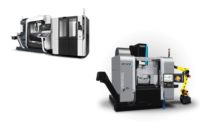INDUSTRY HEADLINE
Machine Control Providers at IMTS 2018 to Focus on Connected Systems

CHICAGO — Job shops don’t have the luxury of scrapping multiple parts to refine a program. They need the first part to be a good part, but achieving this goal has become a bigger challenge as designers have increased part complexity to take advantage of expanding machine capabilities.
“Job shops have to keep pace with new control technology to keep scrape rates low,” said Gisbert Ledvon, TNC business development manager, Heidenhain Corporation. “Continuing to use outdated controls for complex parts is like Einstein’s definition of insanity. If you expect different and better results, then explore the new Control and CAD-CAM technologies showcased at IMTS 2018.”
IMTS 2018 – The International Manufacturing Technology Show, which runs from Sept. 10-15 at Chicago’s McCormick Place, is the industry’s premier resource for connecting with control and software providers. Visitors can explore technology not only in the Controls & CAD-CAM Pavilion, but also in the additive manufacturing, quality assurance, metal cutting and fabricating and lasers pavilions, as well as HANNOVER MESSE USA.
“CNC controls are an integral part of the digital thread that extends from cutting tools to ERP systems,” said Peter R. Eelman, vice president of exhibitions and business development at The Association For Manufacturing Technology, which owns and produces IMTS. “At IMTS 2016, exhibitors were mostly talking about connected controls. At IMTS 2018, visitors can experience connected manufacturing – from design to part as never before.”
While controls are becoming easier to use, they’re also becoming much more powerful. “The controls graphic interfaces, applications and connectivity have expanded their functionality so operators can make intelligent decisions and take immediate action on the shop floor,” said Eelman. “Attending IMTS provides visitors with a rich opportunity to interact with the digital world of manufacturing and see how these capabilities can improve results in their operation.”
Connected Controls
Being able to load a part file or program into a CNC via the USB port was a good advancement for its time. Now, controls connected to CAD-CAM systems allow the operator to access part files, data and set-up sheets without ever leaving the machine and do so in a secure environment.
Of course, personnel working remotely from the CNC, whether in the engineering or QC department or managers at another facility, also want to capture, analyze and act on CNC-related data. Traditional types of data available from CNC controls includes machine status, current program running, spindle speed, availability, utilization rate and errors. Non-conventional data sources include tooling, workholding and discrete machine parts such as pumps, motors and encoders.
“IMTS visitors will notice that control manufacturers have placed a greater focus on importing more data into the machine control via MTConnect-enabled devices,” said Ledvon. “Correspondingly, they have developed software applications that graphically present information so shop owners can more easily make good decisions.” For flexibility, information can remain strictly within a user’s firewalls, can be accessed via the cloud or accessed from both.
IMTS visitors will also notice that machine controls now enable operators to switch the NC program between the desired functions. This gives job shops the freedom to decide how and when they want to combine machining methods, an important development necessary to keep pace with the expanded functions available from 5-axis mill turns. Other improvements include connecting controls to vision systems that can compare the current image to a reference image and spot any deviation from a perfect setup.
“It functions much like the face recognition feature of your iPhone. If something doesn’t look exactly right, the control will find it,” said Ledvon. Examples include missing hole for the next threading application, broken drill in the part, part not clamped correctly in a vice or on pallet, wrong engraved part number on the part and wrong part on the pallet.
Touch for Continuous Improvement
While machine learning and artificial intelligence may ultimately minimize the need for humans to interact with controls, those developments remain over the horizon. For the coming decades, Heidenhain believes that engaging operators is essential for optimizing the machining process.
As a result, new control capabilities include the ability to import a part file, call up a 3D model, zoom and rotate the display using touch screen controls, select portions of the file to modify and have the controls automatically generate new code.
“If operators discover a missing part feature or need to modify the cutting path to avoid a collision, they can make changes without engineering support,” said Ledvon. “Operators working on second or third shift tell us how they finished a batch of parts on time or minimized the number of bad parts because of new control capabilities. Operators also provide immediate feedback to CAD-CAM and quality control systems.”
Ledvon further notes that those working on smaller production runs need to cut the first part correctly. “New control technology makes cutting more accurate and shops more productive by eliminating sources of waste, such as cutting multiple bad parts in order to fine tune the cutting path,” says Ledvon.
AMT’s Eelman added that, “The future is now for the connected manufacturing world and coming to IMTS provides the venue for interaction and engagement with the technologies that will shape the future of manufacturing.”
For more information, visit www.IMTS.com.
Looking for a reprint of this article?
From high-res PDFs to custom plaques, order your copy today!







